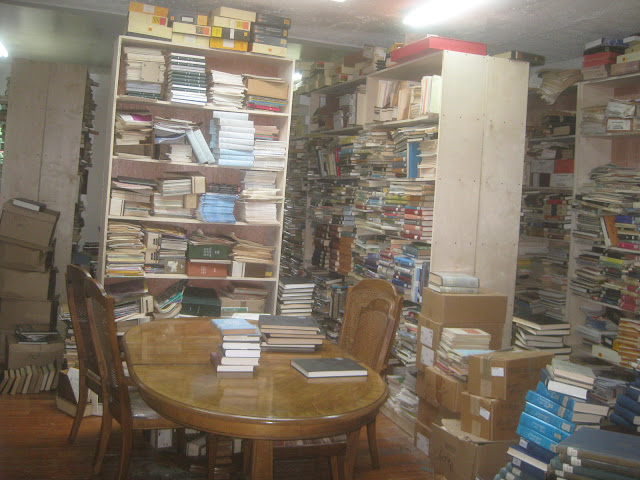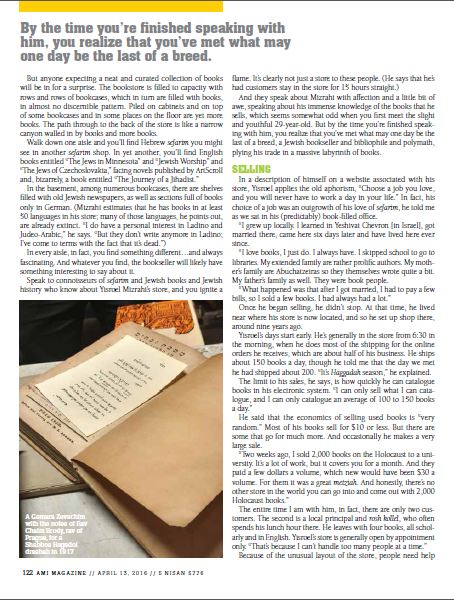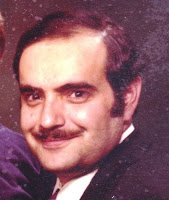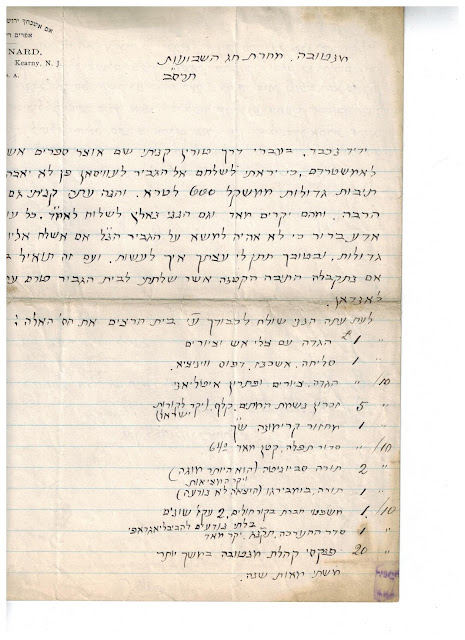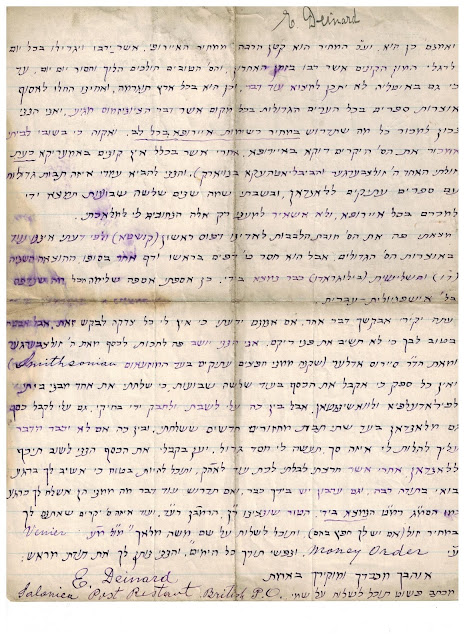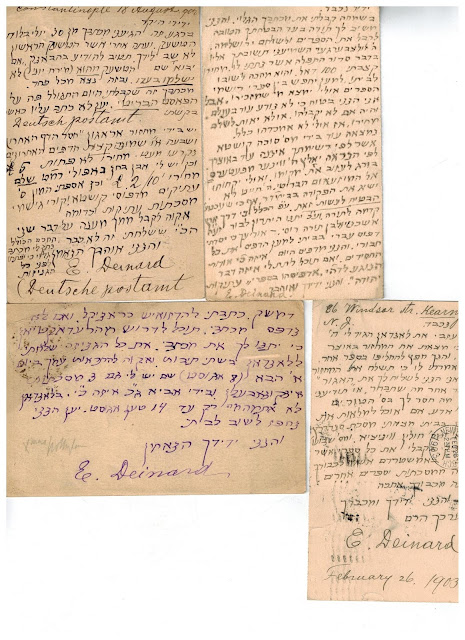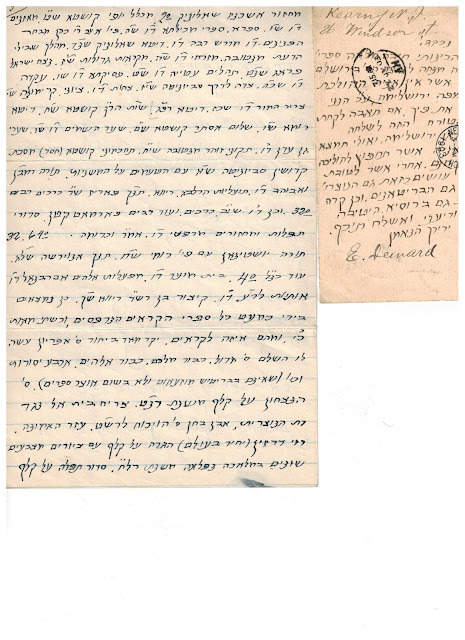The library of Rabbi Aaron Ben-Zion Shurin
Rabbi Shurin was a legendary writer and columnist, most known for his many decades as a columnist for the Jewish Forward. "The Forward, which was a daily from 1897 to 1983 (when it became a
weekly), had enormous influence in the left-leaning Jewish world, and
especially in New York, publishing such luminaries as Isaac Bashevis
Singer and Elie Wiesel. Since 1983, it has had an English-language
counterpart.
Throughout
its history, The Forward was a Socialist, secular publication, and the
presence of Rabbi Shurin, who is Orthodox, was something of an anomaly.
His hiring reflected the feeling of the founding editor, Abraham Cahan,
that the newspaper needed to speak to the religious Jews who flooded the
United States in the 30's and 40's. "
Rabbi
Shurin, who was in his 90s and of Lithuanian origin, represented the 36th
consecutive generation of rabbis in his family. He began writing his
column during the Holocaust and over the years has dealt with subjects
as diverse as the lives of illustrious rabbis, the propriety of women
sitting with men in synagogue, and the impact of court decisions on
funds for yeshivas. Rabbi Shurin was the last surviving student of the Ponovezh Yeshiva in Europe. In addition, Rabbi Shurin taught at Stern College from 1966 until his retirement in 2001.
Rav Shurin received Rabbinical ordination from Rav Isser Zalman Meltzer, Rav Yitzchok Isaac Halevi Herzog, Rav Reuven Katz of Petach Tikvah, and others.
The library containing aprox 2000 volumes, mostly in Hebrew included
many classics as well as obscure works from the last century as well as a
very strong showing of newspapers, from the 19th century through the
WWII period, with many bound volumes of rare newspapers present.
The library of Rabbi Ephraim F. Rubin
Rabbi Ephraim F. Rubin was born in 1920 in the Batei Ungarin section of
Jerusalem. He emigrated to the United States in 1934, and attended
Yeshivot Torah V'Daas and Rabbi Yitzchak Elchanan. He served as an
expert mohel for over 50 years, and disseminated Torah in the Far
Rockaway/ Lawrence community. Rabbi Rubin was not primarily an
antiquarian collector of sefarim. His library consisted mainly of
sefarim which he learned and taught from, Talmud, midrash, rishonim and
halacha. He did, however, collect and enjoy sefarim connected with and
about Eretz Yisrael, haggadot, and brit milah, his life's vocation. He
passed away in 2014.
The library of Jan (Yanek, Yohanan) Adler
Jan (Yanek, Yohanan)
Adler was born in Warsaw on April 6, 1932, where he lived at 19 Hoza
Street with his older brother Kazik (later Ron) and parents Sofia and
Maurizi ( Moshe). His grandparents lived on Twarda
street in the Jewish quarter along with many members of his extended
family, who all perished in the Holocaust. In 1939, during the first
week of the war, Yanek, his parents and his brother managed to escape to
Kovel (Ukraine) where they stayed with extended family. A few months
later they were deported to Siberia where they spent a year freezing and
starving until the Russians set them free in the summer of 1941. They
traveled southwards to Uzbekistan, and there his brother Ron (who was 14
years old) was drafted to the
Anders Army Cadet School (one of only 2 Jews), which was stationed in Palestine (now Israel). Yanek and his parents boarded the famous
Children Of Teheran ship
in 1943 and made Aliya to Israel. Yanek moved to New York in the
1960's, and lived in Queens, where he passed away in March 2016. He was
an amateur historian, a translator and world travel expert, and spent
every moment of free time with his beloved books. He was honored by the
Polish government for his work in bringing together Polish Jews and
non-Jews. You can watch Yanek tell his survival story in more detail in
his own words in this
video.
Yanek's brother, Dr.
Ron Adler, was the Director of MAPI: Israel's Mapping Agency for 20 years and a professor at the Technion. He passed away in 2015.
1944 in Tel Aviv: Yanek, Maurizi, Zofia, and Ron Adler
One of his many bookcases in Queens 2010
School ID from Warsaw 1938-1939 (school year of 1939 never opened because of WWII...)
Summer of 1947, watching the Altalena burn in Tel Aviv
The library of Yosef Shmuel Steinmetz
The library of
Yosef Shmuel Steinmetz, son of the legendary Melamed and Rosh Yeshiva of Torah Vodaath, Rabbi
Moshe Steinmetz , contained aprox. 5,000 volumes. The bulk of his
collection are works of Hasidut, printed within the last 30 years. There
are numerous works of Chabad, Satmar, Bobov, as well as nearly every
other Hasidut present. There are endless different commentaries on the Haggadah,
Avot, as well as numerous classic sets alongside many obscure works.
Nearly every twig of every branch of Hasidut is presented.
Yosef Shmuel was known as a Talmid Chacham who cherished his books and spent any income he had on expanding his library, which he put to very good use. Many in the book community recall him as a friendly fixture at local sefarim stores in Boro Park near his home. In his library, all the Hasidic branches made peace, with books by the Satmar, Sadigura, Chabad and Sanz Rebbes all sharing the same shelves.
The library of Dr. Mordecai Hacohen
Dr. Mordecai Hacohen (1919-2008) was born in Vienna. A member of the Betar Youth Movement, he helped coordinate the clandestine immigration of thousands of Jews to Israel in the run-up to World War II. He went on to help establish the Israeli Foreign Service. A staunch Revisionist Zionist, he found himself thus ousted from Ben-Gurion's government, and wound his way to New York. Of his many extraordinary achievements during his career in New York, was his serving as the Director General of the Otzar Hatorah chain of schools, founded by Isaac Shalom. Tens of thousands of students studied Jewish and Vocational studies in Otzar Hatorah's schools throughout North Africa, the Middle East, France and Iran. His leadership of the organization greatly expanded the reach of this remarkable organization and his natural ability at fundraising helped keep it afloat. Dr Hacohen also served as Senior Vice President of Israel's Bank Leumi, where he was instrumental in promoting investment in Israeli companies. His memoir, Homeland: From Clandestine Immigration to Israeli Independence was published in 2008.

Haggadot
It is that time of year again, and we welcome you to browse through our wide selection of Haggadot now available. Nearly 1,000 different Haggadot are available, with everything from Maxwell House Haggadot to rare 18th century illustrated masterpieces, there is something for everyone. Some highlights include a Haggadah printed on parchment, a Haggadah printed by the Dror Habonim in 1946 in Hungary, The Trieste Haggadah, 2 Yemenite Manuscript Haggadot, a Haggadah with translation to Marathi among much else. You can view the titles available
here.
